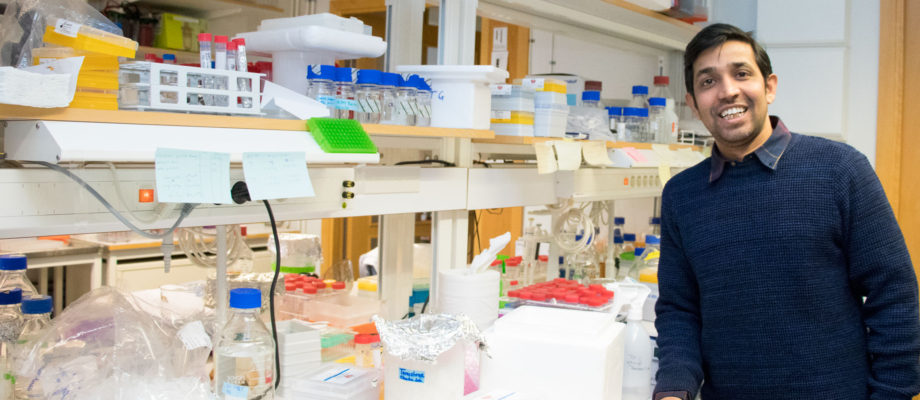GRANTS. Tanmoy Mondal, a postdoctoral research fellow in the Department of Medical Biochemistry and Cell Biology, is now starting his own team to study long non-coding RNA and cancer. He has been awarded a Swedish Research Council Starting Grant, giving him a total of SEK 6 million over the next four years.
Usually the Swedish Research Council announces grant decisions in October, but Molndal received his gratifying news in February. In the evaluation his application received a very high score, and when the Research Council learned that one of those awarded the grant last autumn could not accept it, the council contacted Tanmoy instead.
“It could not have come at a better time for me. This was the last chance for me to get the Starting Grant, because by next year too much time would have passed since defending my doctoral thesis. Of course, I didn’t hesitate to accept,” says Tanmoy, who celebrated the grant with his closest colleagues in the department.
Explosion of discoveries
Tanmoy Mondal’s research focuses on long non-coding RNA in relation to cancer.

“It is a major research field, in which we now know that there are more molecules of non-coding RNA than the RNA that codes for proteins. We know how some non-coding RNA functions, but this is still uncharted territory for most of it. There is a lot to research in the field, and right now it is exploding with new discoveries,” he says.
His focus is neuroblastoma, which is the most common form of childhood cancer of the peripheral nervous system, the part of the nervous system that is not the brain or spinal cord. The disease can occur in the chest, neck, abdomen and adrenal glands and can also spread to the spine. The severity of the disease varies greatly. The mildest form can heal by itself, and in its most aggressive form, this is the deadliest type of childhood cancer. For children afflicted with the most aggressive form of neuroblastoma, treatment succeeds in less than half of the cases.
Researchers believe that neruroblastoma arises during the early development of the nervous system due to defective differentiation in neural crest cells.
“My research concerns the MCYN gene, an oncogene that we know amplified in neuroblastoma. I want to understand its role in the early transformation of human neural crest cells to neuroblastoma tumor cells,” Mondal says.
Another long-term goal is to help develop new kinds of inhibitors that counteract MCYN and to identify the long non-coding RNA that has a significant effect on how neural crest cells function.
Toward better techniques
Another important objective for him is refining and improving the techniques currently used to study non-coding RNA in cancer.
“When we examine the intracellular localization of non-coding RNA and the proteins it interacts with, the techniques available now are not sensitive enough. So in parallel with my other research, I plan to develop better techniques for providing clues about how non-coding RNA functions.”
He is now planning to recruit two additions to his team, probably a postdoctoral researcher and a doctoral student.
“Since my research concerns long non-coding RNA molecules in cancer, there are a number of successful teams in my department and other departments of Sahlgrenska Academy I can work with,” says Mondal, who grew up in East India and received his doctorate at Uppsala University.
He came to Gothenburg in 2012, when he became a postdoctoral researcher in Chandrasekhar Kanduri’s team at Medicinareberget. Recently the group was able to identify two RNA molecules that can be used as biomarkers to determine at an early stage whether the form of neuroblastoma a child has is the most aggressive form, which requires more intense treatment. Tanmoy Mondal was lead author for the work that was published last year in the Cancer Cell journal. The research was conducted in collaboration with teams at Karolinska Institutet and in Germany.
TEXT AND PHOTO: ELIN LINDSTRÖM CLAESSEN











